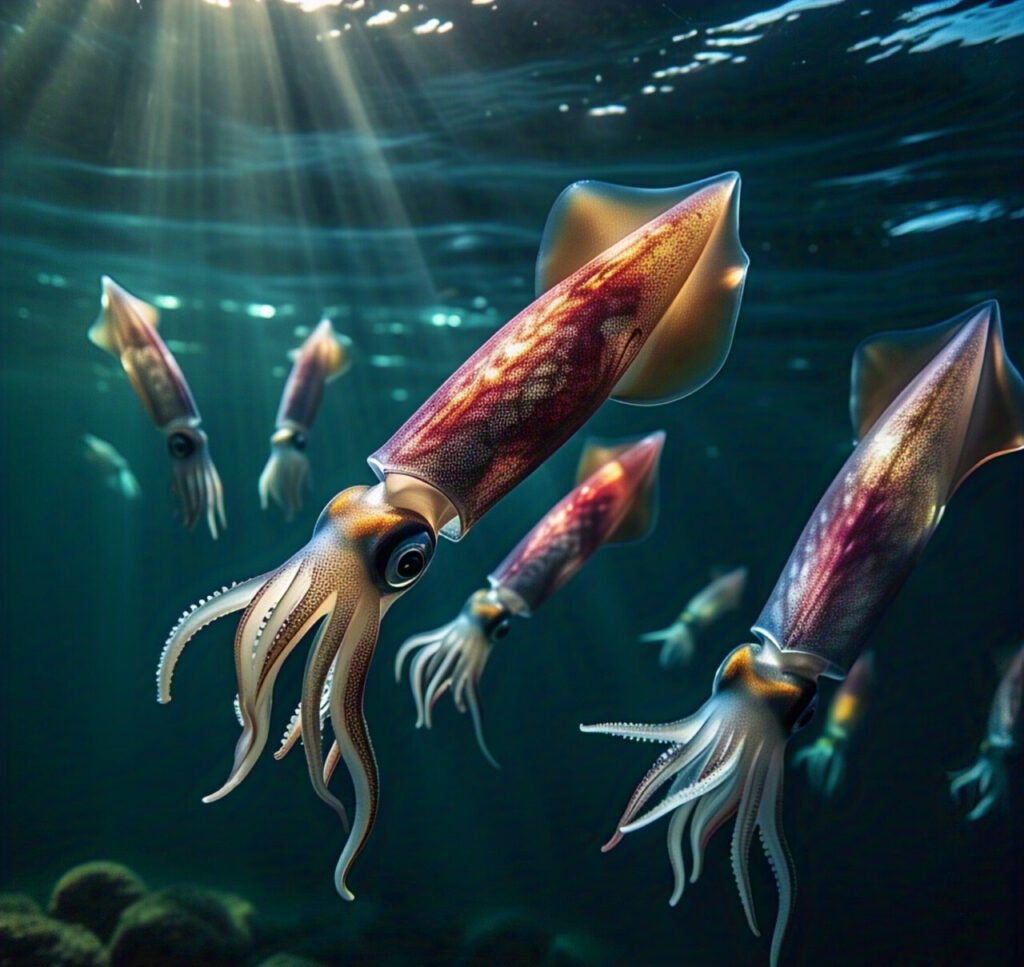Introduction
Stingrays and squids are astounding marine creatures contribute diversely to the sea’s biological system. Understanding the ecological relationship between these two species can help us better grasp the complicated elements of aquatic life. This article explores whether interactions among stingrays and squids influence the oceanic climate and the species’ endurance capacity, addressing the question: is there ecological relationship with squid and stingray.
Understanding Squids: Characteristics & Role in the Ecosystem

The cephalopods, known as squids, are recognized by their arms, smoothed-out bodies, and remarkable knowledge. They are dynamic hunters who eat fish, shellfish, and, surprisingly, different squids. Hunters and prey are crucial in the established pecking order, saving the balance of marine environments. Squids are prominent for the prosperity of the oceans since they help enhance cycling. Learn more about the ecological relationship between squid and stingrays and their role in marine ecosystems.
Understanding Stingrays: Characteristics & Role in the Ecosystem
The cephalopods, or squids, are seen by their appendages, smoothed-out bodies, and remarkable insight. They are dynamic trackers who eat fish, shellfish, and, shockingly, various squids. As the two hunters and prey, they assume an essential part in the pecking order, keeping up with the equilibrium of marine biological systems. Squids are imperative to the soundness of the seas since they likewise help in the cycling of supplements. This raises the question: is there ecological relationship with squid and stingray. Investigating their connections can give further experiences into marine natural elements.
Habitat Overlaps: Where Do Squids and Stingrays Coexist?
Stingrays and squids share marine living spaces in beachfront waters, coral reefs, and open seas. While stingrays typically live near the sea depths, squids are more pelagic. Their living spaces might cover regions like estuaries, where the two species cooperate. These standard regions question their biological relationship and potential cooperation.
Dietary Interactions: Do Squids and Stingrays Compete for Food?
Little fish and shellfish are usual prey for the two stingrays and squids. Contests might result from this dietary cross-over, especially in places with few assets. Then again, stingrays are bottom dwellers, though squids are dynamic trackers. In light of this differentiation, they could live respectively in something similar to marine environments with less immediate rivalry.
Predator-Prey Dynamics: Does One Prey on the Other?

Although larger stingray species may occasionally eat smaller squids, stingrays are not generally known to prey on squids. However, squids can avoid stingrays and other predators because of their agility. Although the evidence does not strongly suggest a substantial predator-prey relationship between the two, sporadic interactions cannot be completely ruled out.
Symbiotic or Neutral Relationship?
The relationship between stingrays and squids is neutral instead of symbiotic. Neither mutualism nor commensalism is evident. However, their cohabitation in similar habitats points to a balance that is advantageous to the ecosystem as a whole. More investigation is required to uncover any potential hidden symbiotic relationships.
Impact of Environmental Changes on Their Relationship
Both stingrays and squids are seriously threatened by habitat loss and climate change. Acidification and rising ocean temperatures may disrupt their habitats and food sources. These modifications may alter their ecological relationship, which could lead to more competition or the need for them to adapt to different environments.
Case Studies & Research Findings
Although few scientific studies have been conducted on squid-stingray interactions, studies on their behaviours offer valuable information. According to marine biologists, there is little interaction between them and no discernible effect on one another’s populations. More targeted research is necessary to grasp their relationship’s subtleties fully.
Human Influence on Squid and Stingray Populations
Habitat destruction and overfishing have severely impacted stingrays and squids. Conservation initiatives are essential to save these species and preserve the equilibrium of marine ecosystems. Marine-protected areas and sustainable fishing methods can help maintain their populations and ecological roles.
Misconceptions About Squid-Stingray Interactions

It is a frequent misperception that stingrays and squids are direct predator-prey. They hardly ever interact and are generally indifferent. Dispelling these myths is imperative to promoting accurate marine conservation efforts and comprehending their genuine ecological relationship.
Why Understanding This Relationship Matters?
Comprehending the relationship between stingrays and squids is essential for marine conservation. This emphasizes how aquatic species are interrelated and how crucial it is to protect their habitats. Preserving these species guarantees the stability and well-being of the marine food web and the larger ocean ecosystem.
Future Research & Unanswered Questions
The connection between between stingrays and squids is still, obscure. Future examinations might analyze their dietary habits, standards of conduct, and responses to natural changes. Researching these aspects will assist us with better understanding their biological relationship and its ramifications for marine preservation, resolving the inquiry: Is there an environmental relationship with squid and stingray.
Conclusion
In rundown, scarcely any immediate cooperations exist, and a generally nonpartisan natural relationship exists among stingrays and squids. The two species contribute to the balance of marine biological systems by assuming fundamental parts in their separate specialities. The prosperity of our seas relies upon safeguarding these species and their living spaces. Together, we should advance marine protection drives and increment public mindfulness.
FAQs
What is the giant squid symbiotic relationship?
The goliath squid cooperative relationship includes bioluminescent microscopic organisms on the squid. These microscopic organisms assist the squid with disguising, while the squid gives them a steady living space and supplements.
What is squid commensalism?
Squid commensalism happens when little living beings, like fish, hitch a ride on a squid for security. The squid stays unaffected, while the more modest creatures benefit from well-being.
What are squirrel symbiotic relationships?
Squirrel cooperative connections incorporate mutualism, like squirrels scattering seeds for plants while acquiring food. These collaborations assist with maintaining biological equilibrium and supporting biodiversity in their natural surroundings.
What are three ecological relationships?
The three biological connections are mutualism (both advantages), commensalism (one advantage, one unaffected), and parasitism (one advantage, one hurt). These connections shape biological systems and species’ step-by-step processes for survival.
What are four ecological relationships?
The four biological connections are mutualism, commensalism, parasitism, and predation. Predation involves one animal category hunting another, managing populations, and maintaining biological equilibrium in regular habitats.
